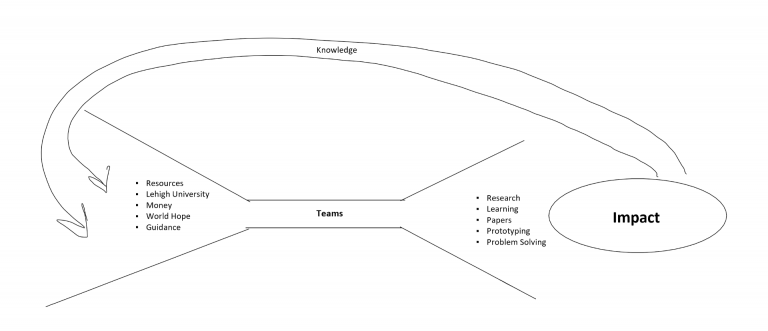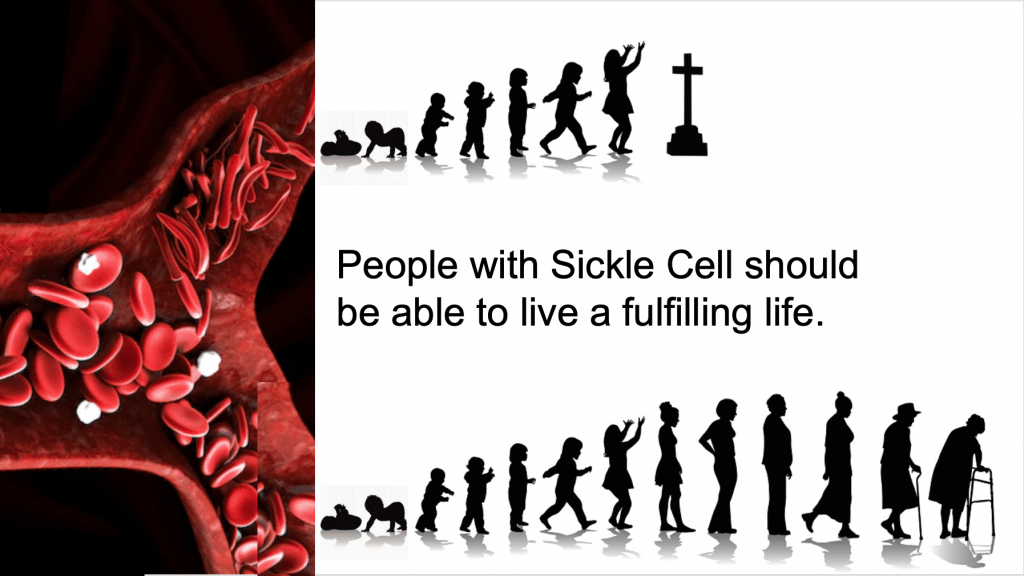Above is the conceptual framework my group created to demonstrate what is unique about GSIF. This conceptual framework highlights two key components:
1. Team-oriented: Knowledge and resources from Lehigh and on the ground-partnerships are channeled through multidisciplinary, student and faculty teams which continue to cycle throughout the long-term duration of the project. These teams turn these inputs into real-world outcomes and impact.
2. The cyclical nature of the project: The impact and knowledge obtained from success and failures of the ventures allows for the teams (new members, continuing members, and members from other teams) to get feedback and push all of the projects forward over the years.
Sickle Cell Conceptual Framework
The goal for the sickle cell team focuses on the idea that all individuals with sickle cell disease should be able to live a fulfilling life. This cover slide demonstrates how sickle cell (a genetic condition where blood cells become sticky and sickle-shaped, causing blood clots), results in reduced life expectancy (among other symptoms); however, our dream is that these individuals should be able to live fulfilling lives, similar to those of individuals with normal blood (symbolized by the difference between the top and bottom graphics).
The conceptual framework highlighting the problem points out three underlying, systemic problems preventing individuals in Sierra Leone with sickle cell from living fulfilling lives. These underlying, healthcare system challenges are
1. Low education on prevalence, causes, symptoms, and management.
2. Limited access to treatments (including financially).
3. No screening programs, and diagnostic capabilities limited to small, isolated programs.
These underlying problems together result in unfulfilling lives for individuals with sickle cell. Specifically, in Sierra Leone, 50-90% of individuals with sickle cell will die before the age of 5, and most of these children are never even diagnosed. In the rare event that a child lives long enough to be present with clinical symptoms, low education, a lack of diagnostic capabilities, and limited access to treatments means that the individual often remains undiagnosed, and even if sickle cell is suspected, they receive no to little guidance on how to handle symptoms or have access to proven, cheap treatments. The only exception to this, is in Freetown and Kono, where individuals at the hospitals who present with clinical symptoms can be referred to programs for official diagnosis, and can receive subsidized treatments and education. Despite this, these programs are limited to a few hundred individuals in these two cities, and do not address the huge proportion of children who die before they present with clinical symptoms, or those who are never referred due to a lack of education. Because of this, the majority of children experience an increased risk for infection, frequent pain crisis, and stigma.
Our solution focuses on a systemic change. By implementing a newborn screening program, individuals with sickle cell can be identified before they present with symptoms, and can start treatments early when they are most effective. Our solution will also incorporate a life-long treatment and education program which will allow the individuals to manage their symptoms, and live fulfilling lives. By collaborating with other sickle cell ventures in Sierra Leone, this solution can be implemented at a national level.
Eight Tenets & Hyacinth Problem
Interdependence
– Relationships that are symbiotic in that when one person makes a decision it directly affects another or the larger system
– An example from malnutrition is while we were in country we were partnering with the bettah bakery. We worked with them to improve their business model but when they decided to not show up or there was huge miscommunication, it directly impacted our efficiency and work for the muffins
Holism
– The individual parts by themselves cannot operate a complex function– this requires all the parts to work together to form a system to perform that function.
– When it comes to distributing our documentary we are going to be unable to do it without the help of other components of the system. For example, we want to distribute our doc through Marie Stopes and they want to help spread the word about maternal health and mortality throughout their system. We each cannot easily do this by ourselves, we each need the other component to reach our desired outcomes and joint outcome of eliminating maternal mortality.
Multifinality
– The same or similar inputs lead to different outputs. Or a win-win situation for all
– Sickle cell diagnostic devices can be used to provide different outputs depending on the context. For example, in Nigeria, sickle cell diagnostics were successful because of their use in family planning, whereas in Sierra Leone programs are more focused on newborn screening efforts.
Equifinality
– The idea that any given output can be reached by a variety of potential means or combination of inputs.
– An example for malnutrition is how we originally created a lot of products that essentially all did the same things but through different “means”. We had different products but ultimately the outcome would have been the same – healthier children
Differentiation
– Each part in the system plays a crucial role and the system would not be whole without each individual part
– An example from the Safe Motherhood team would be when we compiled a list of our stakeholders we wanted to interview, we wanted to include as many people as possible. We needed to get the perspectives of the local community members, the PHU, and the hospitals. Each doctor, nurse, midwife-to-be and mother were essential to understanding the problem of maternal mortality in Sierra Leone to help prevent us from jumping to conclusions.
Regulation
– A process using checks and feedback to make sure goals are being accomplished & taking corrective action
– In the future, the sickle cell team will rely heavily on regulation concepts. For example, during clinical trials, we will need to confirm our test results by comparing our results to the gold standard (either collecting dried blood spot samples or using in-country IEF), and will adjust accordingly.
Abstraction
– “Zooming out” to look at a problem from multiple angles or “zooming in” to see underlying concepts
– For the Safe Motherhood team, we had a point in our fieldwork when we were coming up with all these theories of how Sierra Leoneans are trying to hide the problem of maternal mortality and how we needed to focus our documentary on exposing the truth. But we had to zoom out to look at the problem from different angles to realize that there could be multiple reasons why people were telling us that maternal mortality wasn’t a problem in their clinic. They could be telling the truth that maternal death didn’t happen in their clinic because any deaths occurred after they had referred them to the hospital and therefore they did not count as patients of the clinic.
Leverage Points
– Places within a complex system where a small shift in one thing can produce big changes in anything
– For example, while in Sierra Leone, the malnutrition team had trouble forming connections with the local bakery. Once Khanjan spoke to the owner, they had no further problems. In this case, Khanjan (and his network/power in the community) was the leverage point.
Emergence
– The concept that the value of a system as a whole is greater than the value of the individual parts
– For example, the sickle cell project will represent an emergent system in the future. A sickle cell screening device has very little value without a program (individuals are diagnosed, but nothing is done to address their diagnosis). Similarly, a sickle cell program has very little value without a low-cost screening device (you can’t treat individuals if you don’t know their diagnosis). However, when both parts come together, our project can be very valuable: individuals with sickle cell anemia are diagnosed and then access low-cost treatments to make their lives better and healthier.
Hyacinth Problem:
– In order to solve the problem of allowing the entrepreneur to have access to the hyacinth in the lake, while making the community happy because she is not the only one being paid, our team came up with a solution utilizing the Multifinality principle.
– Solution: The entrepreneur can pay the local community members (or fisherman who are hurt by the high hyacinth levels) to collect hyacinth from the lake. The entrepreneur can then process and sell the hyacinth products for a profit without the community saying she is the only one who is benefitting financially.
– Multifinality: This solution encompasses the Multifinality principles because it is a “win-win,” where one input has multiple beneficial outputs. Specifically, by allowing any community member to collect and sell their hyacinth to the entrepreneur, the entrepreneur “wins” because they have access to the hyacinth without getting push back from the community, and the community “wins” because they can make money by selling the hyacinth.




